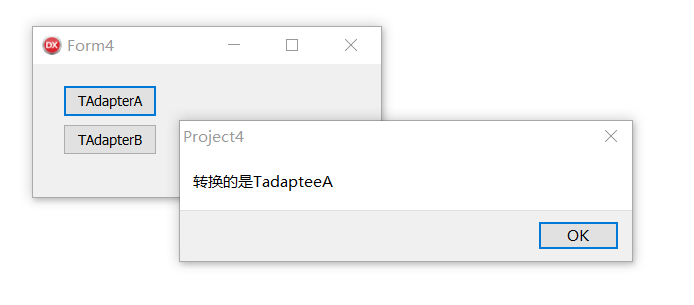1.简介
适配器模式,将一个接口转换成所期待的另外一个接口。这种模式特点,依赖抽象,而不依赖具体。适配器是一个抽象层,用户接口依赖于适配器(抽象层),而不依赖于具体的实现类。当具体类变化时,通过适配器重新转换接口,从而使用代码保持稳定。
unit Unit4;
interface
uses
Winapi.Windows, Winapi.Messages, System.SysUtils, System.Variants,
System.Classes, Vcl.Graphics, Vcl.Controls, Vcl.Forms, Vcl.Dialogs;
type
ITarget = interface(IInterface) //目标使用的特定接口
['{58D98DF5-F85A-430D-84EC-37AA5BFB0EC2}']
procedure Request;
end;
Tadaptee = class(TInterfacedObject)//被适配者,需要匹配的接口
public
procedure SpecificRequest;
end;
TAdapter = class(Tadaptee, ITarget) //适配器,将TAdaptee接口转换成ITarget的接口
public
procedure Request;
end;
TForm4 = class(TForm)
procedure FormCreate(Sender: TObject);
private
{ Private declarations }
public
{ Public declarations }
end;
var
Form4: TForm4;
implementation
{$R *.dfm}
{ TAdapter }
procedure TAdapter.Request;
begin
//适配器进行方法匹配的代码
SpecificRequest;
end;
{ Tadaptee }
procedure Tadaptee.SpecificRequest;
begin
//被适配类的源方法代码
end;
end.
//学习来源于刘艺老师的《模式编程》
以下是具体实现

unit Unit4;
interface
uses
Winapi.Windows, Winapi.Messages, System.SysUtils, System.Variants,
System.Classes, Vcl.Graphics, Vcl.Controls, Vcl.Forms, Vcl.Dialogs,
Vcl.StdCtrls;
type
ICarTarget = interface(IInterface) //目标使用的特定接口
['{58D98DF5-F85A-430D-84EC-37AA5BFB0EC2}']
procedure Request;
end;
TadapteeA = class(TInterfacedObject)//被适配者A
public
procedure SpecificRequest;
end;
TadapteeB = class(TInterfacedObject)//被适配者B
public
procedure SpecificRequest;
end;
TAdapterA= class(TadapteeA, ICarTarget) //适配器,将TAdapteeA接口转换成ITarget的接口
public
procedure Request;
end;
TAdapterB= class(TadapteeB, ICarTarget) //适配器,将TAdapteeB接口转换成ITarget的接口
public
procedure Request;
end;
TForm4 = class(TForm)
btn1: TButton;
btn2: TButton;
procedure btn1Click(Sender: TObject);
procedure btn2Click(Sender: TObject);
private
{ Private declarations }
public
{ Public declarations }
end;
var
Form4: TForm4;
implementation
{$R *.dfm}
{ TAdapter }
procedure TAdapterA.Request;
begin
SpecificRequest;
end;
{ Tadaptee }
procedure TadapteeA.SpecificRequest;
begin
ShowMessage('转换的是TadapteeA');
end;
{ TAdapterB }
procedure TAdapterB.Request;
begin
SpecificRequest;
end;
{ TadapteeB }
procedure TadapteeB.SpecificRequest;
begin
ShowMessage('转换的是TadapteeB');
end;
procedure TForm4.btn1Click(Sender: TObject);
var _AdapterA:ICarTarget;
begin
_AdapterA:=TAdapterA.Create;
_AdapterA.Request;
end;
procedure TForm4.btn2Click(Sender: TObject);
var _AdapterB:ICarTarget;
begin
_AdapterB:=TAdapterB.Create;
_AdapterB.Request;
end;
end.
总结,起初不怎么搞的清楚具体作用,后面百度看了其它博主写的实现,感觉并不符合“适配器”这个名称,他们大部分是定义一个接口或抽象类,然后不同的类继承并覆盖其方法,个人认为严谨的说不应该算“适配器模式”。适配器模式
其实就是先定义一个抽象层,将现有的类进行转换,就才是真真的适配器作用。具体描述参看《模式编程》.这种模式优点是显而易见的,但缺点也很明显那就是执行效率相对低下。本来也在学习中,有不同意见的请指正!